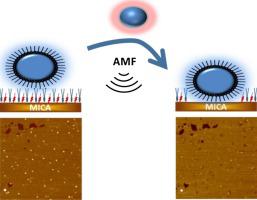Colloids and Surfaces B: Biointerfaces ( IF 5.8 ) Pub Date : 2020-08-09 , DOI: 10.1016/j.colsurfb.2020.111315 Silvia Ruiz-Rincón 1 , Alejandro González-Orive 2 , Valeria Grazú 3 , Raluca M Fratila 3 , Jesús M de la Fuente 3 , Pilar Cea 4

|
Isolated iron oxide magnetic nanoparticles (MNPs), 12 nm in diameter, coated with oleic acid molecules as capping agents have been deposited by the Langmuir-Blodgett (LB) method onto a model cell membrane incorporating 1,2-dipalmitoyl-sn-glycero-3-phosphocholine (DPPC) and Cholesterol (Chol) in the 1:1 ratio, which was also fabricated by the LB technique. Atomic Force Microscopy (AFM) experiments showed that the application of an alternating magnetic field results in the embedding of the MNPs through the phospholipidic layer. These experimental results reveal that the heating of individual MNPs may induce a local increase in the fluidity of the film with a large control of the spatial and temporal specificity.
中文翻译:

通过局部磁力加热改变模型细胞膜。
通过Langmuir-Blodgett(LB)方法将直径12 nm的分离的氧化铁磁性纳米颗粒(MNP)涂有油酸分子作为封端剂,已将其沉积在包含1,2-二棕榈酰基-sn-甘油-的模型细胞膜上比例为1:1的3-磷酸胆碱(DPPC)和胆固醇(Chol)也通过LB技术制造。原子力显微镜(AFM)实验表明,交变磁场的应用导致MNP通过磷脂层嵌入。这些实验结果表明,单个MNP的加热可能会导致薄膜流动性的局部增加,而对空间和时间特异性的控制很大。



























 京公网安备 11010802027423号
京公网安备 11010802027423号